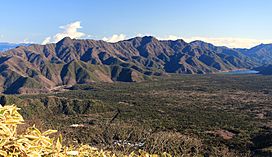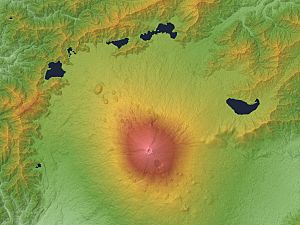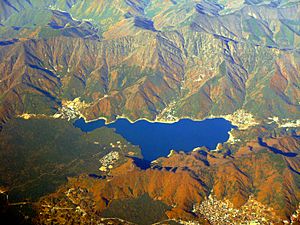Aokigahara facts for kids
Quick facts for kids Aokigahara青木ヶ原 (Japanese)
|
|
|---|---|

Aokigahara, the Misaka Mountains and Saiko Lake, as seen from Mount Ryu of the Tenshi Mountains
|
|
 Aokigahara Mount Fuji  Locations of Aokigahara and Mount Fuji
|
|
| Ecology | |
| Realm | Palearctic |
| Biome | Temperate broadleaf and mixed forest |
| Geography | |
| Area | 35 km2 (14 sq mi) |
| Country | Japan |
| Prefecture | Yamanashi Prefecture |
| Coordinates | 35°28′12″N 138°37′11″E / 35.47000°N 138.61972°E |
| Conservation | |
| Conservation status | Relatively stable/Relatively intact |
Aokigahara (青木ヶ原, 'Blue Tree Meadow') is a famous forest in Japan. It is also known as the Sea of Trees (樹海, Jukai). This forest grows on the side of Mount Fuji, a well-known volcano.
Aokigahara covers about 30 square kilometers (11.5 square miles). It sits on hardened lava from Mount Fuji's last big eruption in 864 CE. The western part of the forest has cool caves that fill with ice in winter. These caves are popular spots for tourists and school trips.
Some parts of Aokigahara are very dense with trees. The special lava rock on the ground absorbs sound. This makes the forest feel very quiet and peaceful. People often feel a strong sense of calm and solitude there.
The forest also has old stories about yūrei. These are ghosts of the dead in Japanese mythology.
Exploring Aokigahara's Geography
The ground in Aokigahara is mostly made of volcanic rock. There are special paths that lead to interesting places. These include the Narusawa Ice Cave and the Fugaku Wind Cave. Another cool spot is the Lake Sai Bat Cave. These are large lava caves found near Mount Fuji. The ice cave stays frozen all year round.
Some people think that compasses do not work well in Aokigahara. It is true that a compass needle might move if placed directly on the lava. This happens because the lava has natural magnetism. However, a compass works perfectly fine when held at a normal height. The Japan Ground Self-Defense Force has even used the forest for navigation training since 1956.
Wildlife and Plants of Aokigahara
Aokigahara is home to many different animals. You can find mammals like the Asian black bear and small Japanese mole. There are also bats, mice, deer, and foxes. Wild boars, rabbits, and Japanese minks live here too. You might even spot a Japanese squirrel.
Many kinds of birds fly through the forest. These include the great tit, willow tit, and long-tailed tit. Woodpeckers, warblers, and jays are also common. You might hear the calls of cuckoos or see a Japanese white-eye.
The forest also has many insects. There are ground beetles and various types of butterflies. Some butterfly species found deep in the forest are Argynnis paphia and Chrysozephyrus smaragdinus.
Aokigahara has a wide variety of trees and shrubs. There are both conifers (like pine trees) and broadleaf trees. Examples include Chamaecyparis obtusa and Cryptomeria japonica. You can also find maples like Acer distylum.
Deeper inside the forest, many flowering plants grow. These include Artemisia princeps and Geranium nepalense. You can also see many mosses and ferns. The edges of the forest have even more plant species.
See also
 In Spanish: Aokigahara para niños
In Spanish: Aokigahara para niños


